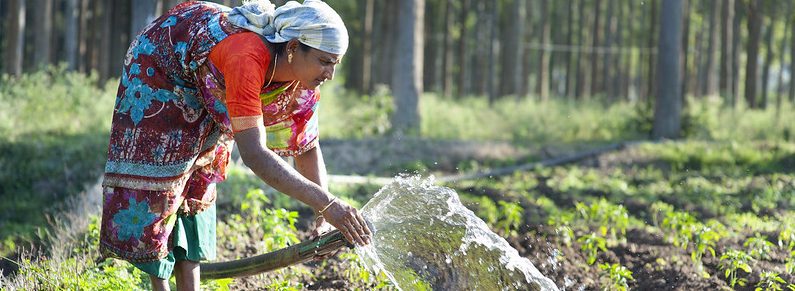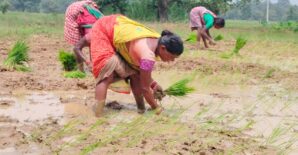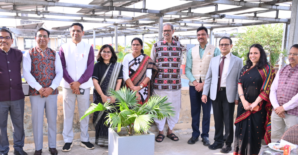
A farmer uses a hosepipe to irrigate crops at her farm in Vazhaithottam village, in the Nilgiris mountains, Tamil Nadu, India. (Pic by Hamish John Appleby / IWMI)
In her recent 2020 budget speech, India Finance Minister Nirmala Sitharaman announced a 16-point agenda to kickstart growth in agriculture and farmers’ income. While the agenda makes sense, following the money presents a disconcerting prospect. Less than 10% of the $30 billion budgeted for agriculture will support capital formation or R&D. Economies can’t grow without investment and innovation. This budget provides money for neither.
Rising subsidies are crowding out resources for investment and innovation. The government’s renewal of the Pradhan Mantri Kisan Samman Nidhi program, known as PM-Kisan, for another year, with an allocation of $10.3 billion, was the most consequential policy decision for the agriculture sector in the budget. This amount is 2.5% of the entire federal budget, and one third of the agricultural budget. In our country subsidies, once started, are seldom rolled back. This scheme will now become an integral part of India’s agricultural policy.
PM-Kisan promises to provide income support of $83 per year to all land-owning families in three equal installments. The amount is the same for all landholding families, irrespective of their holding sizes. Tenants and those engaged in allied activities like animal husbandry, fisheries, etc., don’t qualify for the benefits if they don’t own farmland.
Since its launch in December 2018, 89 million landowners have received more than $6.9 billion in cash transfers under this scheme. The 2015-16 Agricultural Census counted 146.5 million farm holdings in India. If the Census estimates were correct, 60.6% of all landowners in India have received at least one PM-Kisan installment by Feb. 10, 2020. An average beneficiary has received $78 of the $110 (or 2.85 of the four installments) due to them. However, there are significant variations between states. West Bengal is not implementing the scheme, while in the Andaman & Nicobar Islands, Assam, Manipur, and Punjab, the number of beneficiaries is larger than the total number of landholdings estimated by the Census. In Punjab, the number of PM-Kisan beneficiaries is twice as large.
Is $83 a year sufficient for farmers to make a real impact on agriculture, or their lives? Depends. For large farmers in Punjab, it is a relatively small amount. In contrast, in Bihar, where two thirds of the 16.6 million farmers own less than 0.2 hectares of land, $83 can fully pay for the inputs used to grow paddy or wheat. The 11 million smallholders of Bihar earn less than the PM-Kisan entitlement from a crop of rice or wheat. So, the PM-Kisan entitlement is not small when compared to the average earnings of India’s 81 million smallholders (those with less than 0.2 ha) from one season of growing a cereal or a pulse crop.
Can we expect any direct impact of the cash transfers on India’s agriculture? I am not sure. PM-Kisan is not an agricultural subsidy. It is an income support, equal in value to the annual National Food Security Act entitlement of a family of five, but only for landowners. It will definitely lead to an increase in the welfare of these families, and is progressive in its design. A farmer with 0.25 ha land gets the same amount of cash as another one with 25 ha of land. So, the welfare impact will be much larger for poor, sub-marginal, and near-landless farmers than for larger landowners. However, I do not expect PM-Kisan to lead to agricultural intensification. Agriculture in India is a high-risk, low-returns activity. Farmers would rather spend the money they get on other activities with better, more assured returns.
Lump-sum transfers are more efficient than distortionary price subsidies, but the problem is that PM-Kisan has not replaced any existing subsidy program. It is yet another freebie and will further crowd out investments and R&D in agriculture. This already evident in India’s budget. If the goal of PM-Kisan is to reduce rural distress, it seems unfair that the fund allocation for it is 22% higher than the Mahatma Gandhi National Rural Employment Guarantee Scheme (MGNREGS) ($10.3 billion and $8.4 billion, respectively). There are more farm laborers than farmers in India, and the former are poorer. Rural distress is affecting them just as much, if not more.
Avinash Kishore is a Research Fellow with IFPRI's South Asia Regional office in New Delhi. This post first appeared in the Financial Express. Opinions are the author's.
This blog was first posted in ifpri.org



